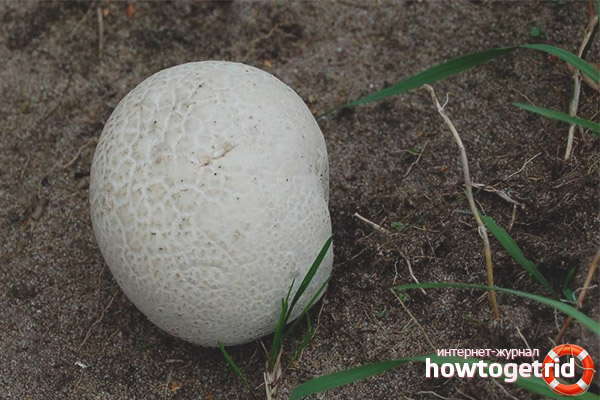The content of the article
Fans of picking mushrooms know the many names of this amazing representative of the mushroom family. The giant golovach is famous for its incredible size, so in mycology it is often known as a giant raincoat or giant langerium. Thanks to the unusual “round hat” in the shape of a head that the fruit body of the fungus has, mushroom pickers often call these representatives of the plant world quite consonantly - golovachy. Indeed, in nature, the shape of these mushrooms is very similar to the head. Another name for these mushrooms - "raincoat", appeared due to the fact that most of these gigantic mushrooms appear in a wooded area after long and heavy rains.
Characteristics of the giant golovach
The giant mushroom is considered to be edible; it belongs to the family of champignon mushrooms. In nature, gigantic raincoats can grow to incredible sizes. The diameter of a large head can reach up to 35 centimeters in width, while the weight of the mushroom can vary within 10 kg. There are cases when mushroom pickers managed to detect a gigantic mushroom even weighing up to 25 kg.
It is generally accepted that the golovach of a yellow, green or brown hue is unsuitable for food. Collect in a basket and eat such a mushroom is not worth it. It is best to eat the young fruits of the head mushrooms, which have white fruits. It was at this time that the raincoat had the most delicious and snow-white core. Inside the pulp of mushrooms is very similar to cotton wool. Young mushrooms of golovachy have a special characteristic smell, and among mushroom pickers raincoats giants are famous for their unique taste. Fans of mushrooms and culinary experts note that golovachy get a special and unique taste when frying in a pan. However, it is worth remembering that you need to try such a delicacy within 24 hours after a mushroom crop has been harvested. After a day, the giant mushroom becomes unsuitable for eating.
The raincoat is poisonous
Also, lovers of picking mushrooms should not be confused with a giant golovach with his poisonous congener - a false raincoat. This inedible mushroom looks very much like a giant raincoat, but it is very dangerous for health. You can distinguish these two fungi according to some external signs, for example, the fruits of a puddle rain inside and outside have a darker color than that of a real golovach.
Golovacha giant growing environment
Golovachye mushrooms are not in vain got their nickname, because they are undeniable champions in heavy weight in the realm of edible mushrooms. When they first met in the forest, mushroom pickers did not immediately realize that the real fruit body of a giant golovach was growing in front of them.Giant raincoats cannot be found in the same area several times, they can appear on a specific territory and then disappear for a long period. Varieties of such "nomadic mushrooms" are called meteor mushrooms by scientists.
Golovachi can be called single mushrooms, since, unlike their relatives, they do not grow in groups. Best of all, a giant raincoat grows in the soil rich in moisture, nitrogen and other nutrients. That is why often golovachy can be found in places with high humidity. As a rule, they grow on the edges of mixed and deciduous forests, in the damp lowlands of meadows and fields, in wet ravines and steppes. Mushrooms grow after heavy rains, you can find them with the onset of June and up to the beginning of October.
Useful properties of a giant raincoat
The fruits of the mushrooms are endowed with a very useful substance called calvacin. This miraculous substance has properties that are beneficial to health, which is why it is often used in home medicine to treat kidneys, problems associated with leukemia and tumor formation. Pharmaceutical companies also use the medicinal properties of the fungus to create medicines. Medicinal products for the treatment of tuberculosis, diabetes, and asthma are created from the raincoat spores. Also, a giant mushroom is part of a vaccine that treats the flu. This mushroom is able to cleanse the body of toxins and radionuclides, its spores help to heal wounds. The healing properties of the giant raincoat can help patients with smallpox, laryngitis and overcome the development of urticaria.
Cooking golovacha giant
To prepare the mushroom, the shell should be removed, and the pulp itself should be cut into small layers. Pieces of mushrooms are well fried in breading, this gives them a special sophistication of taste. It is enough to dip the chopped mushroom in batter or bread crumbs, after which it must be fried on both sides in oil.
At the same time, chefs do not advise to experiment and cook the fruits of a giant golovach in water. After cooking, this mushroom absorbs a lot of moisture and becomes very unpleasant in taste. However, the variety of this giant mushroom lends itself very well to drying. After that, the raincoat can be very easily used in other recipes and added to different dishes.
Video: giant golovach (Calvatia gigantea)











Submit